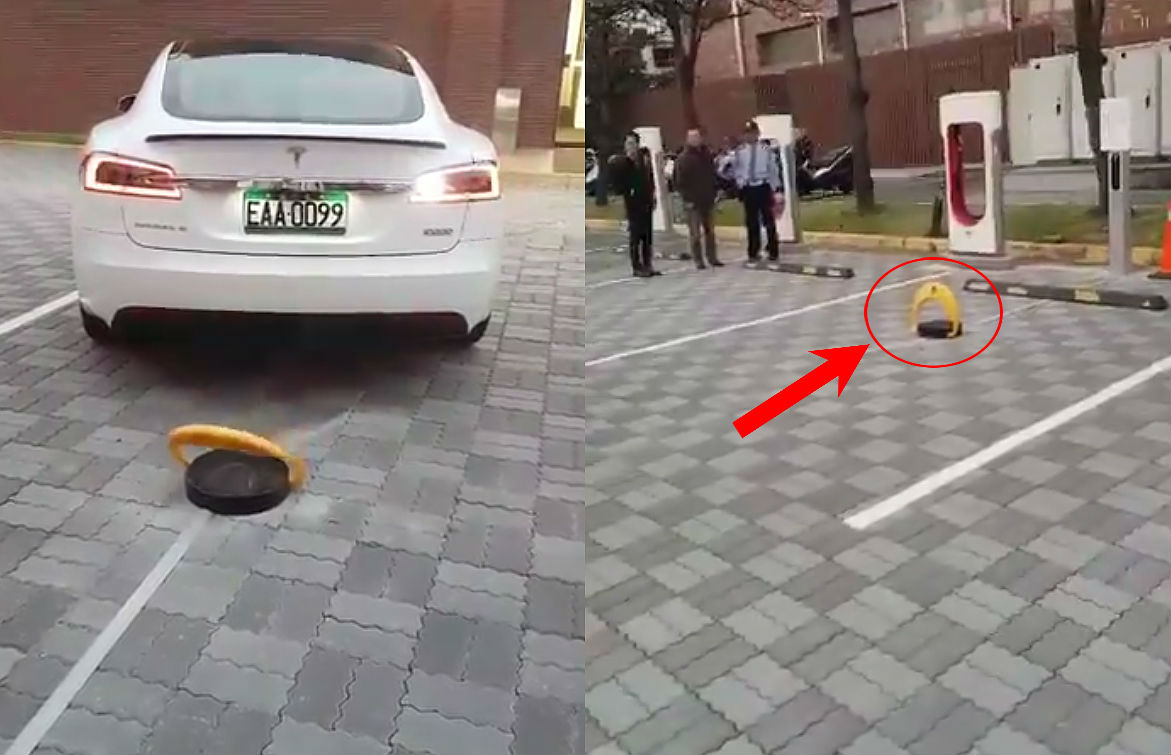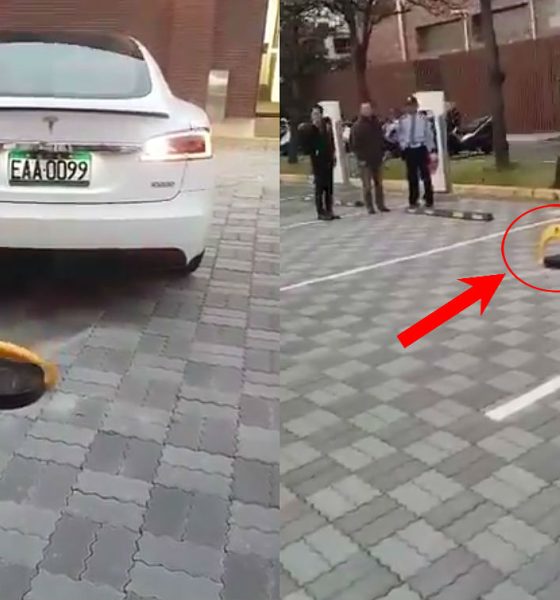

News
Tesla tests Supercharger blocking device to prevent gas cars from ‘ICEing’ charging stalls
Tesla is testing a clever solution to prevent Superchargers from getting blocked (intentionally or unintentionally) by fossil fuel-powered vehicles. In a recent video shared online, the electric car maker is seen using camera-enabled ground locks to ensure that only Tesla vehicles can access a Supercharger.
A video of the system in action has been shared by the Tesla Owners Taiwan group on Twitter. In their post, the group noted that the Supercharger ground locks are fitted with a camera that identifies a Tesla electric car via its license plate as the vehicle is backing up. Upon identification, the ground lock would promptly unlock and lower itself, allowing the Tesla to gain access to the charging station.
Tesla Taiwan testing out new supercharger ground locks solution to fix ICE issues. A camera identifies the Tesla via plate number as the car backs up and unlocks accordingly. @elonmusk @tesla pic.twitter.com/tFU1twMBdg
— Tesla Owners Taiwan (@TeslaOwnersTwn) February 14, 2019
Tesla China used a similar system last month to prevent ICE-ing incidents. As could be seen in previous social media posts from Chinese Tesla owners, the method employed in the country utilized locks that could be unlocked through QR codes linked to an app. Between the two systems, Tesla Taiwan’s solution appears to be a bit more convenient, considering that the Supercharger lock itself determines if a vehicle is a Tesla or not.
In China here is our creative solution to the ICEing problem. Well done to Tesla China for this great solution. Mostly all of the new Tesla Supercharger Station have these installed. Takes less than one minute of your time. #Tesla #TeslaChina #ICEing pic.twitter.com/gBPXVoORxU
— Jay in Shanghai 电动 Jay 🇨🇳 (@JayinShanghai) January 13, 2019
A comparison of the two systems also shows Tesla Taiwan’s locks being a bit taller than those employed in China. This makes them more effective, as they can deter vehicles with higher ground clearance, such as SUVs and pickup trucks. Of course, Tesla Taiwan’s system is not foolproof, as owners of lifted vehicles could easily drive over the ground locks. Nevertheless, the presence of the locks would likely discourage a good number of would-be ICE-ers to think twice before parking on a Supercharger spot.
View from inside car pic.twitter.com/fpTqbIPcfS
— Tesla Owners Taiwan (@TeslaOwnersTwn) February 14, 2019
Such Supercharger lock systems appear to be used in territories outside the United States for now. Considering the seemingly increasing number of ICE-ing incidents in the US, it would be a good idea for Tesla to implement a similar system in areas where it is able. Granted, such a method would not prevent ICE-ing incidents completely, but it would likely decrease the number of blocked Superchargers significantly.
Incidents of Supercharger ICE-ing, wherein a fossil fuel-powered vehicle blocks a charging station (intentionally or unintentionally) have been a prominent source of annoyance for the Tesla community for years. While some ICE-ing incidents result from honest mistakes or simple carelessness, reports from members of the electric car community over the past couple of months have indicated that some owners blocking the EV charging stalls have been quite aggressive towards Tesla owners. These anti-Tesla incidents escalated last month, when vandals practically attacked a Supercharger by partially severing cables, and later, drilling through the stalls’ charging plugs.

News
Nvidia CEO Jensen Huang explains difference between Tesla FSD and Alpamayo
“Tesla’s FSD stack is completely world-class,” the Nvidia CEO said.

NVIDIA CEO Jensen Huang has offered high praise for Tesla’s Full Self-Driving (FSD) system during a Q&A at CES 2026, calling it “world-class” and “state-of-the-art” in design, training, and performance.
More importantly, he also shared some insights about the key differences between FSD and Nvidia’s recently announced Alpamayo system.
Jensen Huang’s praise for Tesla FSD
Nvidia made headlines at CES following its announcement of Alpamayo, which uses artificial intelligence to accelerate the development of autonomous driving solutions. Due to its focus on AI, many started speculating that Alpamayo would be a direct rival to FSD. This was somewhat addressed by Elon Musk, who predicted that “they will find that it’s easy to get to 99% and then super hard to solve the long tail of the distribution.”
During his Q&A, Nvidia CEO Jensen Huang was asked about the difference between FSD and Alpamayo. His response was extensive:
“Tesla’s FSD stack is completely world-class. They’ve been working on it for quite some time. It’s world-class not only in the number of miles it’s accumulated, but in the way it’s designed, the way they do training, data collection, curation, synthetic data generation, and all of their simulation technologies.
“Of course, the latest generation is end-to-end Full Self-Driving—meaning it’s one large model trained end to end. And so… Elon’s AD system is, in every way, 100% state-of-the-art. I’m really quite impressed by the technology. I have it, and I drive it in our house, and it works incredibly well,” the Nvidia CEO said.
Nvidia’s platform approach vs Tesla’s integration
Huang also stated that Nvidia’s Alpamayo system was built around a fundamentally different philosophy from Tesla’s. Rather than developing self-driving cars itself, Nvidia supplies the full autonomous technology stack for other companies to use.
“Nvidia doesn’t build self-driving cars. We build the full stack so others can,” Huang said, explaining that Nvidia provides separate systems for training, simulation, and in-vehicle computing, all supported by shared software.
He added that customers can adopt as much or as little of the platform as they need, noting that Nvidia works across the industry, including with Tesla on training systems and companies like Waymo, XPeng, and Nuro on vehicle computing.
“So our system is really quite pervasive because we’re a technology platform provider. That’s the primary difference. There’s no question in our mind that, of the billion cars on the road today, in another 10 years’ time, hundreds of millions of them will have great autonomous capability. This is likely one of the largest, fastest-growing technology industries over the next decade.”
He also emphasized Nvidia’s open approach, saying the company open-sources its models and helps partners train their own systems. “We’re not a self-driving car company. We’re enabling the autonomous industry,” Huang said.
Elon Musk
Elon Musk confirms xAI’s purchase of five 380 MW natural gas turbines
The deal, which was confirmed by Musk on X, highlights xAI’s effort to aggressively scale its operations.

xAI, Elon Musk’s artificial intelligence startup, has purchased five additional 380 MW natural gas turbines from South Korea’s Doosan Enerbility to power its growing supercomputer clusters.
The deal, which was confirmed by Musk on X, highlights xAI’s effort to aggressively scale its operations.
xAI’s turbine deal details
News of xAI’s new turbines was shared on social media platform X, with user @SemiAnalysis_ stating that the turbines were produced by South Korea’s Doosan Enerbility. As noted in an Asian Business Daily report, Doosan Enerbility announced last October that it signed a contract to supply two 380 MW gas turbines for a major U.S. tech company. Doosan later noted in December that it secured an order for three more 380 MW gas turbines.
As per the X user, the gas turbines would power an additional 600,000+ GB200 NVL72 equivalent size cluster. This should make xAI’s facilities among the largest in the world. In a reply, Elon Musk confirmed that xAI did purchase the turbines. “True,” Musk wrote in a post on X.
xAI’s ambitions
Recent reports have indicated that xAI closed an upsized $20 billion Series E funding round, exceeding the initial $15 billion target to fuel rapid infrastructure scaling and AI product development. The funding, as per the AI startup, “will accelerate our world-leading infrastructure buildout, enable the rapid development and deployment of transformative AI products.”
The company also teased the rollout of its upcoming frontier AI model. “Looking ahead, Grok 5 is currently in training, and we are focused on launching innovative new consumer and enterprise products that harness the power of Grok, Colossus, and 𝕏 to transform how we live, work, and play,” xAI wrote in a post on its website.
Elon Musk
Elon Musk’s xAI closes upsized $20B Series E funding round
xAI announced the investment round in a post on its official website.

xAI has closed an upsized $20 billion Series E funding round, exceeding the initial $15 billion target to fuel rapid infrastructure scaling and AI product development.
xAI announced the investment round in a post on its official website.
A $20 billion Series E round
As noted by the artificial intelligence startup in its post, the Series E funding round attracted a diverse group of investors, including Valor Equity Partners, Stepstone Group, Fidelity Management & Research Company, Qatar Investment Authority, MGX, and Baron Capital Group, among others.
Strategic partners NVIDIA and Cisco Investments also continued support for building the world’s largest GPU clusters.
As xAI stated, “This financing will accelerate our world-leading infrastructure buildout, enable the rapid development and deployment of transformative AI products reaching billions of users, and fuel groundbreaking research advancing xAI’s core mission: Understanding the Universe.”
xAI’s core mission
Th Series E funding builds on xAI’s previous rounds, powering Grok advancements and massive compute expansions like the Memphis supercluster. The upsized demand reflects growing recognition of xAI’s potential in frontier AI.
xAI also highlighted several of its breakthroughs in 2025, from the buildout of Colossus I and II, which ended with over 1 million H100 GPU equivalents, and the rollout of the Grok 4 Series, Grok Voice, and Grok Imagine, among others. The company also confirmed that work is already underway to train the flagship large language model’s next iteration, Grok 5.
“Looking ahead, Grok 5 is currently in training, and we are focused on launching innovative new consumer and enterprise products that harness the power of Grok, Colossus, and 𝕏 to transform how we live, work, and play,” xAI wrote.








